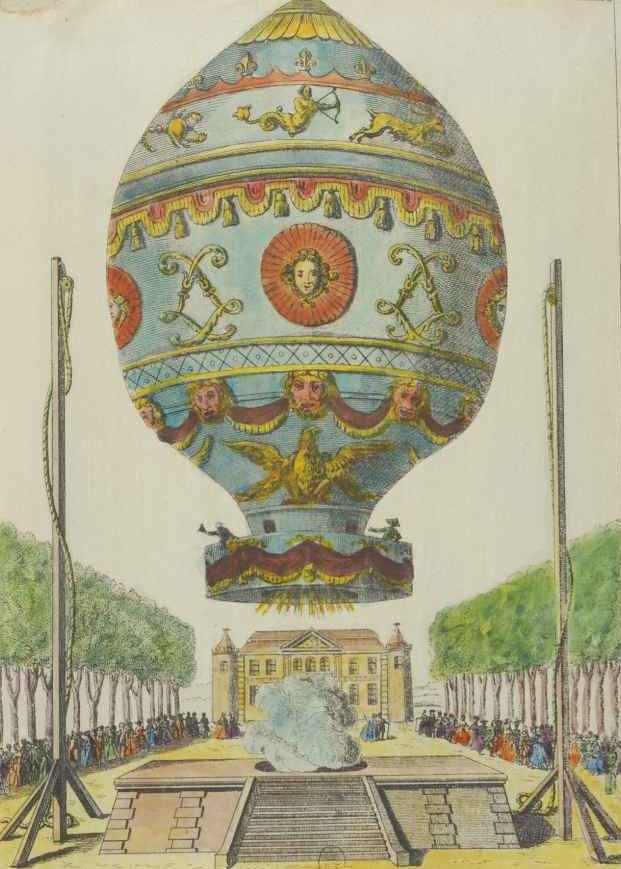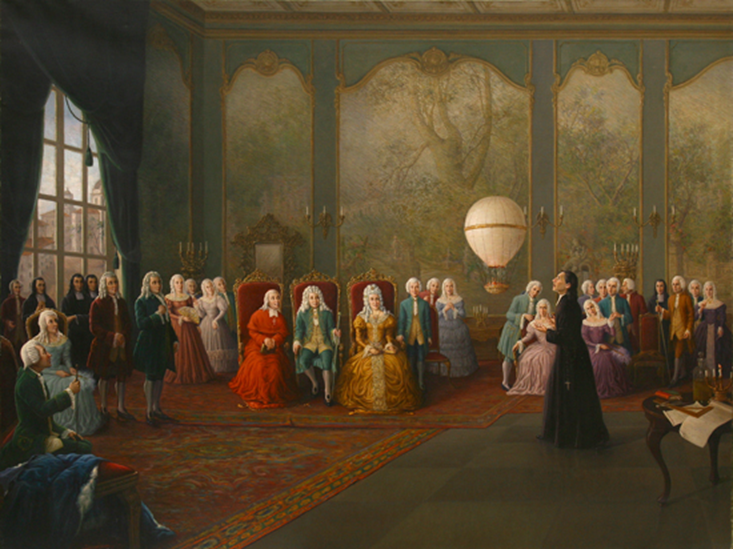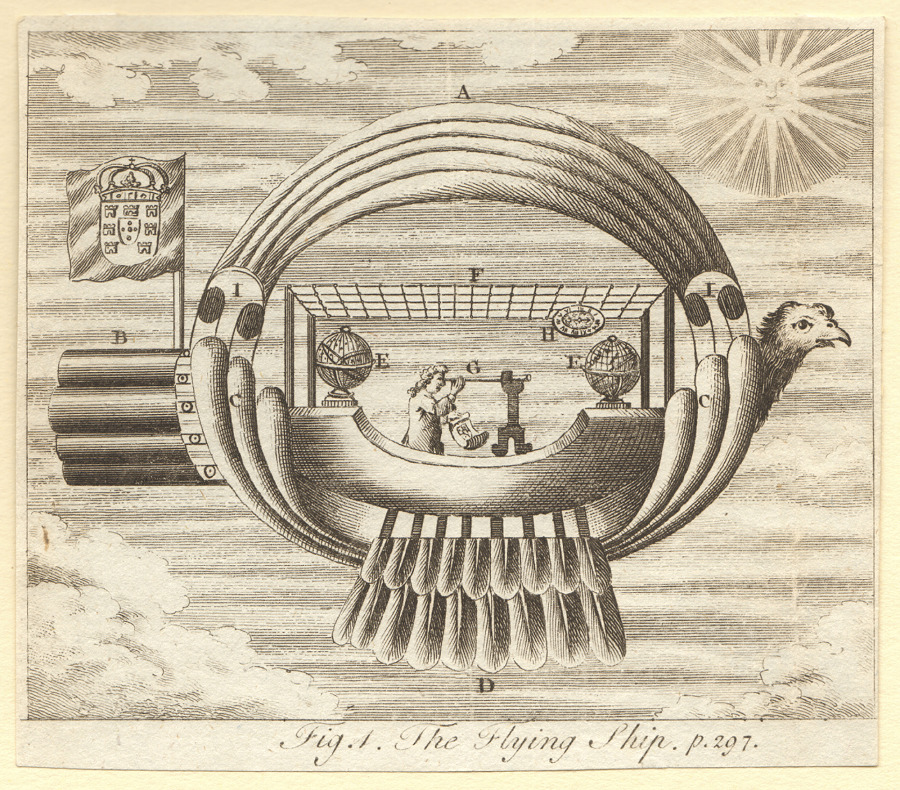Balloons and the Creation of the World's First Air Force
Beginnings, Military
18 September 2020
In 1678, Issac Newton published his Principia Mathematica where he derived the basis of the drag equation, which is crucial to modern aerodynamic calculations. It wasn’t until the year 1709 that the next major accomplishment in aviation was achieved.
Bartolomeu de Gusmão was a Brazilian priest who pioneered the design of lighter-than-air aircraft. He is best known for planning a bird-like airship that would be lifted using hot air. Unfortunately, it was never built. Often overlooked, his most important contribution to aviation was the demonstration of a working hot air balloon. He was invited before the king in which his small hot air balloon flew indoors for a short period of time before it was extinguished in fear of fire.
Bartolomeu de Gusmão: (1) Presenting his hot air balloon in front of John V of Portugal. Painting by Bernardino de Souza Pereira, 1709. (2) Gusmao's design for a hot-air lifted airship. Image via the Smithsonian Institution.

Nearly seventy years later, the Montgolfier brothers came along. Jacques-Etienne and Joseph-Michel Montgolfier became well known for their experiments in building and flying large scale hot air balloons. In 1783 they were the first to make a manned flight in a balloon, and did so by burning wool and straw under the canopy - much like modern day hot air balloons which use propane instead. Although their work came such a while later than the work of Gusmão, many people falsely believe that the Montgolfier brothers were the first to fly a hot air balloon. Indeed, the brothers are much more well documented and appreciated for their contributions to aviation than Gusmão.
Later that year, the chemist Jacques Charles was inspired by the Montgolfiers, who had become quite famous in France. The recent chemical revolution made it known to scientists that hydrogen gas was lighter than air and could operate on a similar principle to a balloon. He constructed a hydrogen balloon and called it Le Globe. Its flight was a success, until the landing in which villagers attacked and destroyed it, not knowing what it was.
Fascinated by such flights, more people became balloonists, popularizing the concept and spreading it around the world. One such man was Jean-Pierre Blanchard. His balloons were not unique, but he became the first to deliver international mail by air, from England to France. Additionally, he brought ballooning to North America with a flight from Philadelphia to New Jersey.
The creation of balloons also led to the creation of the first air force - the Compagnie des Aerostiers, or "Company of Aeronauts" in France. Fifty men formed the company, who used balloons to observe and communicate with infantry soldiers.
With the creation of the balloon, aviation really began to take hold in the world. Evidently, its potential to be used for both transport and military was noticed and utilized almost immediately. Today, the legacy of the balloon is carried on through applications like weather observation, and leisure balloon flights.

Fearful villagers in Gonesse attack Le Globe. Public domain.
References
- Cooper, Ralph S. "Bartolomeu Lourenço De Gusmão." Early Aviatiors. Accessed September 18, 2020. https://www.earlyaviators.com/egusmao.htm.
- The Editors of Encyclopaedia Britannica. "Balloon." Encyclopædia Britannica. Encyclopædia Britannica, inc., February 24, 2020. https://www.britannica.com/technology/balloon.
- The Editors of Encyclopaedia Britannica. "Jean-Pierre Blanchard." Encyclopædia Britannica. Encyclopædia Britannica, inc., June 30, 2020. https://www.britannica.com/biography/Jean-Pierre-Francois-Blanchard.
- The Editors of Encyclopaedia Britannica. "Joseph-Michel and Jacques-Étienne Montgolfier." Encyclopædia Britannica. Encyclopædia Britannica, inc., February 6, 2018. https://www.britannica.com/biography/Montgolfier-brothers.
- "Father Bartolomeu Lourenço De Gusmão." Jesuit Stamps 1898 - 2016. Accessed September 18, 2020. https://www.manresa-sj.org/stamps/1_Gusmao.htm.
- The Flying Ship. , None. [Between 1710 and 1790] Photograph. https://www.loc.gov/item/2004665410/.
- Gillispie, Charles Coulston. The Montgolfier Brothers and the Invention of Aviation 1783-1784: With a Word on the Importance of Ballooning for the Science of Heat and the Art of Building Railroads. United States: Princeton University Press, 2014.
- Guttman, John. "First Military Aviatior." Aviation History, November 2012. https://www.historynet.com/first-military-aviator.htm.
- Haydon, F. Stansbury., Crouch, Tom D.. Military Ballooning During the Early Civil War. United Kingdom: Johns Hopkins University Press, 2000.
- "Isaac Newton's Principia Mathematica." The British Library, January 27, 2015. https://www.bl.uk/collection-items/newtons-principia-mathematica.
- Joel, Lucas. "Benchmarks: June 4, 1783: The Era of Aviation Launches with the First Balloon Flight." EARTH Magazine, June 28, 2016. https://www.earthmagazine.org/article/benchmarks-june-4-1783-era-aviation-launches-first-balloon-flight.
- Kim, Mi Gyung. "‘Public’ Science: Hydrogen Balloons and Lavoisier's Decomposition of Water." Annals of Science 63, no. 3 (August 3, 2006): 291–318. https://doi.org/10.1080/00033790600610494.
- Luoro, Francisco Videira, and Joao Melo de Sousa. "Father Bartholomeu Lourenço De Gusmão: a Charlatan or the First Practical Pioneer of Aeronautics in History." AIAA Journal, January 13, 2014.
- The Montgolfier Brothers' Balloon. The Museum of Flight, May 16, 2016. https://www.museumofflight.org/Exhibits/montgolfier-brothers-balloon.
- Valadares, Paulo. "Bartolomeu De Gusmão, O Messias Desconhecido." Mestre em História Social, 2007. http://www.asbrap.org.br/documentos/revistas/rev14_art2.pdf.

